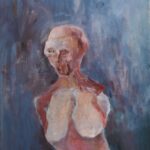
Tarejeva Ieva
The exhibition “Synthetic Organicity” held in 2017 is the first personal exhibition of artist Ieva Tarejeva. Choosing painting as one of the currently most acceptable means of expression, the author analyzes topics relevant to her: the aestheticization of the environment and especially the body, physiological memory, and the transience of the body. Having completed her studies at the Vilnius Academy of Arts, Department of Monumental Painting this year, and having joined the “Butoh” dance troupe “Okarukas” last year, Ieva Tarejeva will present the skills she has acquired and the reflections she has accumulated at the exhibition.
The author about the exhibition: “As long as the hair on our head is beautiful to us, and when it falls out, it is disgusting, the same with teeth, nails and bodily fluids.
How perverse is the aestheticization of the body?
What is the essence of a person when you break down bodily associations? This will be important in the works on display.
When I paint, I scale associatively, expressing myself through surfaces. The painting turns into a body, the body turns into a plant, spills out and creates a space for its own existence. I pay a lot of attention to experiments, layer by layer I grow synthetic organicity, in which the reflection of each observer is possible.
The body of the painting becomes a spectacle felt by the senses.
Awakens the memory of the bodies observing.
Human. Animal. Insect. Plant.
Meat. Skin. Bone. Fabric. Fluids.
Joints.
This is how I would describe the works if I had to use a few words.”
***
What feelings does your urine give you? And saliva? What do you think about your earwax? Your face is probably at least a little wrinkled now. However, have you ever thought that all this is your body? Why are you pulling your hair out of the bathroom with disgust? That which was just a part of you. Maybe your soul is just getting used to your body… This is probably not the kind of love that teachers of a happy life preach about. However, isn’t that how it should be?
These questions of the aestheticization of the body, physiological memory, and the transience of the body are raised by artist Ieva Tarejeva in her first personal exhibition “Synthetic Organicity”. Choosing painting as one of the most acceptable means of expression, Ieva analyzes topics relevant to her by painting in a unique “relief” technique.
What is the main idea of the exhibition “Synthetic Organicity”?
In the works of the exhibition, I analyze a person and his physiology. I provoke the viewer by depicting the body from an angle that may not be acceptable to everyone. In my opinion, man has always been and will remain mysterious to himself, and therefore interesting.
What does the body symbolize in this exhibition?
It is the essence of the exhibition. Through the body, I analyze time and temporality, the relationship of space to the body, and one of the most relevant topics – the aestheticization of the body. If the body is the home of the soul, I wonder if the soul tames it by settling in the body. Of course, everything becomes more complicated in the context of today.
The body is very expressive – it says a lot about a person’s lifestyle, quality, habits and experiences. Body language is one of the forms of communication that is the most difficult to control, therefore it is the most sincere expression of communication. By turning paintings into bodies, I strive to make the dialogue between the viewer and the painting as sincere as possible, so that the body of the painting communicates with the body of the viewer.
Why the name “Synthetic Organicity”?
Because by experimenting with synthetic materials, paints and various pigments, I try to obtain surfaces, colours and textures close to physiological structures.
What is body aesthetics to you?
If you ask me what kind of body I find aesthetic, the short answer is – healthy. However, from this point of view, I often catch myself in moments when certain standardisations from the environment, certain requirements come to mind. I encounter a lot of such things especially as a woman.
I also see another side in body aesthetics – further from society, closer to each individual. I often wonder why parts that are separated from the body, such as skin, hair, teeth, etc., cause nausea or other repulsive feelings. I guess that what the body “loses” becomes lifeless and has a direct connection with death. The presence of death nearby, especially in Western culture, is difficult to accept.
What should a viewer know before going to the exhibition?
The fact that the paintings are painted with love for the human body, although looking at some works, it may seem the opposite.
Text: Eglė Nešukaitytė
Art critic Jolanta Marcišauskytė-Jurašienė about Ieva T.’s works:
However, one important element remains – the “body”, which is not simply “depicted” by painting it on a plane, on the surface of the canvas, but is immediately intertwined with it, as if still forming and alive, because it is seen differently depending on the angle and lighting.


